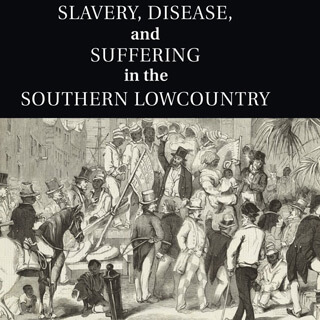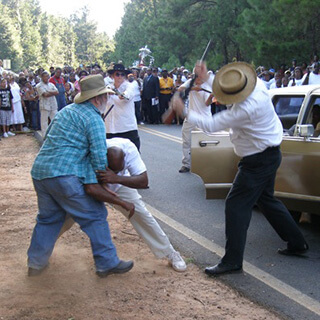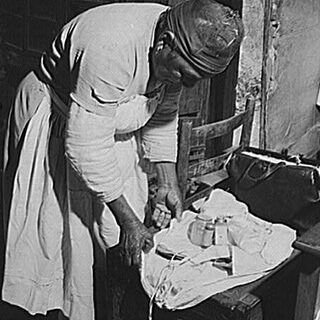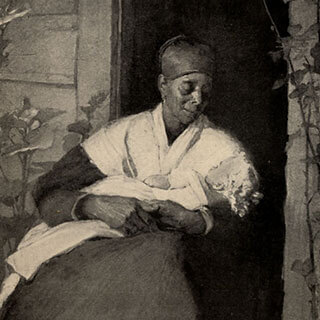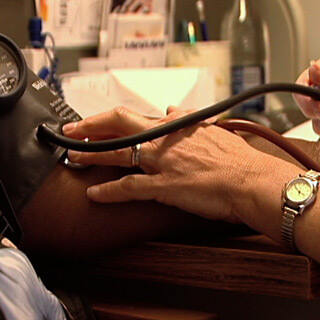Overview
Peter McCandless reviews Marli F. Weiner with Mazie Hough, Sex, Sickness, and Slavery: Illness in the Antebellum South (Urbana: University of Illinois Press, 2012).
Review
 |
A Gullah proverb warns, "every sick ain't fa tell de doctor" ("don't tell the doctor all your ailments"). After reading Sex, Sickness, and Slavery, the wisdom of that saying seems more obvious, especially as it applies to women and blacks in the antebellum South. The late Marli Weiner, a professor of history at the University of Maine, demonstrates convincingly how antebellum southern physicians—white males all—used information about their patients to advance their own professional and sectional political agendas.1Sadly, Professor Weiner died before the book was completed. Mazie Hough, assistant professor of history and women's studies at the University of Maine, helped to finish and prepare the book for publication. They actively used medical science to justify racial and sexual hierarchies, to define and characterize bodies by sex, race, and place, and to enhance their authority as physicians and white men. In the process, they wrestled with the problem of what Weiner calls "ambiguous bodies" (mixed race, sexual hybrids, and "monstrosities") and with the complex relationships between minds and bodies.
Unfortunately, Weiner does not define her South. Her evidence derives from many of the states in which slavery was legal before the 1860s, but overwhelmingly from the plantation country of the Lower South, from South Carolina to Louisiana. She draws on a wide variety of sources: medical journals, diaries, letters, notes, and daybooks. The activities of Weiner's southern physicians were not unusual, as she is well aware. A similar process was going on throughout the western world as doctors, divided into regular and irregular sects, sought to raise their professional status and authority. They portrayed women as the weaker sex, physically and mentally crippled by the demands of their reproductive functions and their "crises"—menarche, menstruation, pregnancy, menopause. Doctors believed that mind and body interacted most violently in the case of the female sex. Men became ill too, of course, but their diseases were more idiosyncratic and their emotional control greater than in the case of women. Physicians in the South used their medical knowledge to justify slavery as well as the subordination of women.
As Weiner cogently argues, the US South was unique in that the process of medically subjecting women intersected with the need to subordinate blacks to the demands of the slave economy. A crucial assumption held that whites were unsuited for field labor in the hot, feverish lowlands. In contrast, blacks were viewed as admirably adapted for it by providential design or the experience of living in Africa for millennia. Place—climate and landscape—was crucial to comprehending southern diseases and their influence on society. Antebellum southern physicians could not entertain the notion that blacks and whites might be fundamentally the same under the skin. That line of thought might lead to the idea that slavery was morally wrong. Some late-eighteenth century planters and physicians had concluded it was, and that slavery was at best a necessary evil. Their descendants, faced with the growth of northern abolitionist sentiment, closed ranks behind the idea that slavery was a positive good. Southern physicians—themselves often planters or from planting families—came to their aid. "As slaveholders became ever more anxious about defending the peculiar institution on which they depended," Weiner writes, "southern doctors' claims of scientific authority sometimes took the form of providing anatomical and physiological arguments to support it. They increasingly argued that race carried with it bodily differences that justified the subordination of those of African descent, who were deemed biologically inferior to those who enslaved them. Doctors' growing contribution to the defense of slavery simultaneously enhanced their own prestige and that of the science in which they wrapped their claims" (3).
 |
| John Adams Whipple, Louis Agassiz, January, 1865. |
With great thoroughness, Sex, Sickness, and Slavery documents how physicians eagerly brought the evidence of medical science to the aid of the proslavery argument. Some argued for polygenesis, the idea that God had created several races separately, with the white superior to the rest. Others claimed that blacks had their own peculiar diseases. Scientific support for such views came in part from northern comparative anatomists such as Louis Agassiz and Samuel George Morton. Agassiz was popular in the South for being an advocate of polygenesis and the racial inferiority of blacks. Morton, of Philadelphia, was an avid skull collector who proved to his satisfaction that blacks had smaller skulls than whites and therefore smaller brains and less intelligence.
Sex, Sickness, and Slavery describes how southern physicians such as Josiah Nott and Samuel A. Cartwright drew on the works of Agassiz and Morton, adding their own experiences in treating blacks. This is all familiar material that Weiner uses to develop her own narrative. Nott devoted a great deal of effort to advocating polygenesis and annoying clergymen who rejected it as unscriptural. He posited a firm and fixed racial hierarchy, with big-brained, high facial-angled Caucasians sitting on top as God intended. Blacks and whites, he declared, were separate species and nothing could change one into the other. Mulattoes were a "degenerate Hybrid race" (97). They might be more intelligent than pure Negroes but they were weaker, more infertile, and more disease-prone than either of what Nott called the "pure" races. "Wild" Africans had been improved by the domesticating process of slavery. Freedom, however, would bring a rapid deterioration in their condition, especially if they moved to a colder climate. The (allegedly) high mortality and morbidity rates of free blacks in the North, Nott claimed, proved his point.
Samuel Cartwright was the most prolific and imaginative discoverer of diseases purportedly peculiar to the Negro. He gifted the world with drapetomania, the disease that caused slaves to run away, and dysoesthesia Ethiopia ("rascality") which caused blacks to do "mischief owing to the stupidness of mind and insensibility of the nerves" (29). The latter condition was presumably more common among free blacks than slaves because the former lacked white control. Many black diseases, Cartwright maintained, arose from defective atmospherization of the lungs, depriving oxygen to their brains, which could only be combated by keeping them actively at labor. The best way to prevent and treat their diseases was to keep them under control in the position for which God had designed them, that of the "submissive knee bender" (28).
Weiner is careful to show that Nott's and Cartwright's opinions were viewed as extreme even in the South. Many physicians rejected polygenesis and/or questioned the immunity of blacks to tropical diseases. Nearly all agreed, however, that black bodies responded differently to disease than white bodies. Both suffered from the same diseases but to different degrees due to physiological differences. They debated what aspects made blacks medically suitable for slavery, but southern physicians accepted the assumption that slavery benefited blacks, and some actively sought to provide medical evidence for it. Southern physicians had no difficulty justifying black subjugation.
 |
| Carol M. Highsmith, Anatomical model acquired in Paris by Josiah C. Nott for the Medical College of Alabama, Mobile, Alabama, 2010. Library of Congress, Prints and Photographs Division,LC-DIG-highsm-05221. |
Justifying the domination of women should have been even easier. European and northern academics and physicians had already provided plenty of arguments and evidence. Nevertheless, as Sex, Sickness, and Slavery shows, southern physicians faced a unique problem: how could they reconcile arguments for sexual and racial subordination in a way that did not undermine either? They had to categorize people by both race and gender, and in ways that supported male gender and white racial superiority. Few physicians doubted white or male supremacy, but a coherent racial ideology required that white women be shown to be superior to black men. Moreover, if women were indeed the weaker and sicklier sex, demanding protection and gentle care, how could one justify making black women perform hard physical work alongside black men, even when close to giving birth and shortly after delivering?
Antebellum physicians could not ascribe white women's frailties to black women, Weiner argues, because the primary function of the black race was to perform hard labor. Nor was it possible to say that black women were naturally stronger than white women. That would call white superiority into question. Instead, drawing on contemporary beliefs about the enervating effects of civilization, physicians argued that black women were more primitive than white women, closer to nature, less refined, and more susceptible to pain and the debilitating effects of the reproductive system. Civilized life had weakened white women, leaving them prey to physical and mental infirmities.
The physicians' argument had its dangers as Weiner observes: it veered close to saying that civilization itself was a bad thing. That would never do, because whites grounded their claims to racial dominance on the superiority of their civilization. For many southern doctors, the solution was obvious: white women were themselves partly to blame. They were leading unhealthy lives, exacerbated by the emotional influence of their reproductive systems. They were also endangered—as black women were not—by their addiction to unhealthy fashions such as wearing tight corsets and numerous petticoats, eating luxury foods, smoking, and drinking alcohol. The emotional instability and unhealthy habits of white women produced numerous diseases of body and mind, of which the protean hysteria was one of the most common. Their minds, dominated through "sympathy" by their uterus and ovaries, needed as much care as their bodies. White men and blacks could suffer from hysteria but it was predominately a disease of white women.
Southern physicians, as Weiner shows, felt constrained to explain black women's diseases in ways that would not undermine the slave economy. A common rationalization was to define black women as less dominated by complex reproductive functions but more highly sexualized than white women. If a white woman was a uterus writ large, a black woman was a vagina with diseases to match, notably syphilis. The supposedly simpler minds of black women were also less burdened by disease-producing anxieties than white women, as long as masters supplied basic needs.
Following on the work of historians such as Todd Savitt and John Harley Warner, Sex, Sickness, and Slavery examines another way in which antebellum southern physicians sought to expand their authority: by emphasizing the importance of place to disease. Weiner examines physicians' beliefs that climate and environment were imagined to influence southern bodies in ways that made them react differently to disease than northern bodies. The Deep South climate, too hot for Europeans and too cold for Africans, produced a unique configuration of diseases, different from those of the North or the tropics. These difficulties could be overcome, however, through acclimation and proper medical care. Southern bodies and diseases required a southern ("states-rights") medicine which included training in southern medical schools. Doctors trained at northern schools, especially if they had never lived in the South, lacked the needed expertise and experience.
Weiner's most innovative chapters, although drawn from limited sources, look at everyday attitudes towards disease. Laypeople of both races had their own ideas about health, many of them common sense assumptions mixed with theological and magical beliefs. They sometimes contested the physicians' claims to expertise. White women often refused to allow physicians to examine them and found advice such as "control your emotions" less than helpful. Doctors lamented the failure of white women to follow their advice and submit to their examinations, attributing it to the same emotional instability that caused many of their diseases. Not surprisingly, enslaved women distrusted white physicians. For their part, physicians often accused blacks of shamming (which some doctors even labeled a mental disease). Blacks tended to understand the causes of disease—whether natural or supernatural—as external to their bodies, demonstrating a lack of control over their own lives. In contrast, whites saw disease largely as internal, a matter of how body and mind reacted to disease agents. Both races turned to traditional folk remedies, including magical ones like conjure and hoodoo. Weiner acknowledges that this part of her story is less complete than her analysis of medical ideas, because lay people, especially blacks, left little written evidence. Most of her sources derive from the Deep South. She draws heavily on interviews of former slaves and folklore. As many historians have pointed out, and Weiner acknowledges, much of this evidence is problematic because it was filtered through white interviewers and collectors.
Weiner's thoroughly documented and well-organized book is a welcome addition to medical history. Her argument might have been strengthened by some discussion of the pre-antebellum roots of southern medical thinking, particularly those relating to the impact of climate and environment on disease. One thinks of Lionel Chalmers' Weather and Diseases of South Carolina (1776) and the medical works of David Ramsay. Slavery itself was responsible for many of the most deadly diseases of the southern environment, such as falciparum malaria and yellow fever, as I and others have shown. Many parts of Weiner's picture will be familiar to students of southern and medical history, but her overall canvas, deftly incorporating the views of both races and genders, of both physicians and laypeople, is unique and insightful. Above all, she has made a powerful case for the importance of medical men and ideas in undergirding slavery and white supremacy. 
About the Author
Born in Scotland but currently residing in London, Peter McCandless has lived in the United States for most of his life, mainly in Chicago and Charleston, South Carolina, where he taught history for thirty-four years at the College of Charleston. His publications include Slavery, Disease, and Suffering in the Southern Lowcountry (Cambridge University Press, 2011), co-winner, SHEAR Prize for best book on the history of the early American republic for 2011 and Moonlight, Magnolias, and Madness: Insanity in South Carolina from the Colonial Period to the Progressive Era (University of North Carolina Press, 1996).
Recommended Resources
Dusinberre, William. Them Dark Days: Slavery in the American Rice Swamps. Athens: University of Georgia Press, 2004.
Fett, Sharla. Working Cures: Healing, Health, and Power on Southern Slave Plantations. Chapel Hill: University of North Carolina Press, 2002.
Humphreys, Margaret. Malaria: Poverty, Race, and Public Health in the United States. Baltimore: Johns Hopkins University Press, 2001.
McCandless, Peter. Slavery, Disease, and Suffering in the Southern Lowcountry. Cambridge, MA: Cambridge University Press, 2011.
McMillen, Sally. Motherhood in the Old South: Pregnancy, Childbirth, and Infant Rearing. Baton Rouge: Louisiana State University Press, 1990.
Numbers, Ronald L. and Todd L. Savitt, eds., Science and Medicine in the Old South. Baton Rouge: Louisiana State University Press, 1989.
Savitt, Todd L. and James H. Young, eds., Disease and Distinctiveness in the American South. Knoxville: University of Tennessee Press, 1988.
Stowe, Stephen M. Doctoring the South: Southern Physicians and Everyday Medicine in the Mid-Nineteenth Century. Chapel Hill: University of North Carolina Press, 2004.
Warner, John Harley. The Therapeutic Perspective: Medical Practice, Knowledge, and Identity in America, 1820-1885. Princeton, N.J.: Princeton University Press, 1997.
Similar Publications
| 1. | Sadly, Professor Weiner died before the book was completed. Mazie Hough, assistant professor of history and women's studies at the University of Maine, helped to finish and prepare the book for publication. |
|---|
